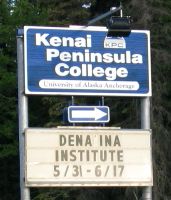Dena’ina Language Revitalization Efforts
Like many of Alaska’s Native languages, Dena’ina is severely endangered. Official and unofficial policies of the United States government, like the forced removal of children to residential schools, have contributed to the decline of spoken Dena’ina. Today only a small number of active speakers remain, and children no longer grow up speaking Dena’ina, but several projects are underway to help reverse the trend and bring spoken Dena’ina back into daily life.
One such project is being conducted by Lake Clark National Park. As part of its survey of the western Cook Inlet region, the Park is working to create a comprehensive catalog of all known Dena’ina audio recordings. The recordings are found in various locations, from the Alaska Native Language Center in Fairbanks to the Bureau of Indian Affairs ANCSA Office and personal collections. Dr. James Kari has inventoried over 350 recordings so far.
Another venture is Project Jukebox, a joint effort between the UAF Rasmussen library and Lake Clark National Park. The project has compiled interviews with elders, photos and maps into an interactive CD-ROM. The Project Jukebox website is found at http://uaf-db.uaf.edu/Jukebox/lakeclark/home.html. </p>
Several major books on Dena’ina culture and language have been published. The best known of these are A Dena’ina Legacy: K’tl’egh’i Sukdu by Peter Kalifornsky (1991), and Shem Pete’s Alaska: the Territory of the Upper Inlet Dena’ina by Kari and Fall (2003). These two books contain valuable information on Dena’ina history, culture, geography and language, and collections of traditional and new stories. Also of interest are Priscilla Russell’s works on Dena’ina ethnobotany (Tanaina Plantlore, Dena’ina K’et’una: An Ethnobotany of the Dena’ina Indians of Southcentral Alaska, 1987) and ethno-ornithology (Bird Traditions of the Lime Village Area Dena’ina: Upper Stony River Ethno-Ornithology, 2003).
 Recently members of the Dena’ina community have begun working more actively on language revitalization. The large size of Dena’ina territory, which covers both urban and rural areas, poses a challenge, and bringing together speakers and learners can be difficult. In an effort to draw together members of the Dena’ina community from across the region, the Kenaitze Indian Tribe hosted the first Dena’ina Festival in May 2003. More than 100 people attended. The Festival was followed by the first Dena’ina Language Institute, a three-week intensive language course held at Kenai Peninsula College and sponsored by the University of Alaska Fairbanks. That first year, only ten students attended, but interest in the Institute has grown quickly. Nearly forty students attended in 2004, and fifty students attended in 2005.
Recently members of the Dena’ina community have begun working more actively on language revitalization. The large size of Dena’ina territory, which covers both urban and rural areas, poses a challenge, and bringing together speakers and learners can be difficult. In an effort to draw together members of the Dena’ina community from across the region, the Kenaitze Indian Tribe hosted the first Dena’ina Festival in May 2003. More than 100 people attended. The Festival was followed by the first Dena’ina Language Institute, a three-week intensive language course held at Kenai Peninsula College and sponsored by the University of Alaska Fairbanks. That first year, only ten students attended, but interest in the Institute has grown quickly. Nearly forty students attended in 2004, and fifty students attended in 2005.
The yearly Language Institutes are structured so that elder speakers serve as mentors to language learners in conversation classes. Other classes are offered as well, including classes in Dena’ina literacy, linguistics, Native Language education, and computer skills. Different classes are offered each year so that returning students can build upon knowledge they gained in previous years.
Recently, the Alaska Native Heritage Center received a grant from the Department of Education for Dena’ina Qenaga Qunuhdulzex (“The Dena’ina Language is Coming Back”), and the Kenaitze Indian Tribe has received significant funding from the Administration for Native Americans to create a Dena’ina Archive and promote language learning. Both endeavors will produce curricular materials for teaching Dena’ina language, and will archive existing Dena’ina resources.
Complementing all these efforts is the Dena’ina Archiving, Training and Access grant (DATA), which is creating the digital archive found on this website. The archive contains a catalog of all the Dena’ina materials at the Alaska Native Language Center and provides access to most of them. This project also provides training to Dena’ina community members in the use of the archive, and in using technology to further the language revitalization effort.
Collaborative efforts like the ones undertaken by the Dena’ina community provide access to research, documentation, and recordings of Dena’ina language. Language revitalization is an achievable goal. Revitalization can take many forms, but it always requires a strong commitment from the community. This community clearly has what it takes to bring back the language that has a long-standing connection to the collective history, culture and values of the Dena’ina people.
Adapted from Gaul & Holton (2004) Speaking across generations: Dena’ina language revitalization in Southcentral Alaska. Alaska Park Science.